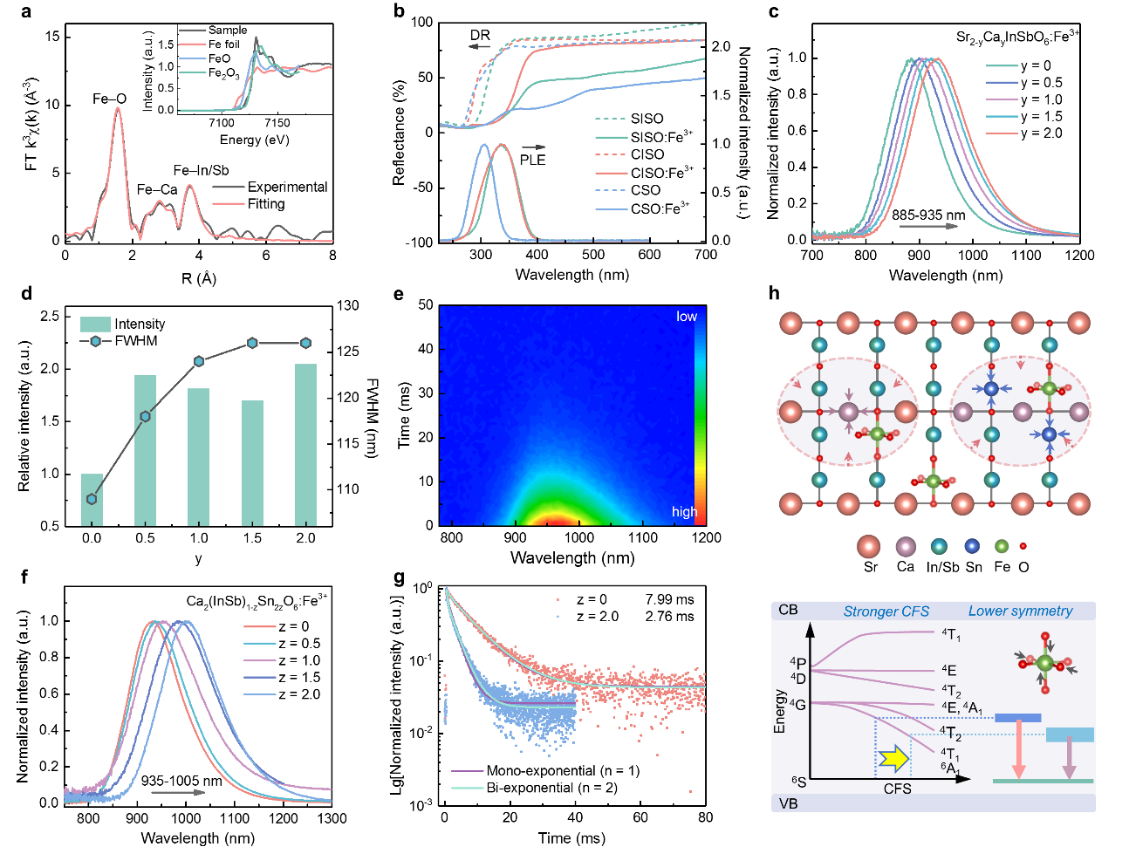Near-infrared (NIR) light has been widely used in fields such as plant cultivation, night vision, food analysis, and biomedicine. With the increasing popularity of smart devices, it is necessary to develop small-sized NIR light sources. Traditional tungsten halogen lamps are not portable, and NIR light-emitting diodes (LEDs) suffer from narrow spectral bandwidths. Therefore, NIR-emitting phosphor-converted LEDs have attracted much attention due to their small size, high efficiency, and tunable broadband emission. Although numerous NIR-emitting phosphors have been reported, developing efficient and broadband NIR-emitting phosphors remains challenging. Recently, Prof. Guogang Li’s group and Prof. Jun Lin’s group have realized the Fe3+-activated Sr2-yCay(InSb)1-zSn2zO6 broadband NIR-emitting phosphor material with tunable emission wavelength. Highly efficient broadband NIR emission is achieved via a cation substitution strategy, demonstrating the tunable NIR luminescence properties of Fe3+.

Figure 1. PL tuning of Sr2-yCay(InSb)1-zSn2zO6:Fe3+.
The study shows that the introduction of Ca2+ and Sn4+ can cause lattice shrinkage, which affects the crystal field environment around Fe3+, thereby tuning its luminescence properties. Under excitation at 340 nm, the Sr2InSbO6:Fe3+ phosphor shows a broadband NIR emission band centered at 885 nm. With the cation substitution of Ca2+ for Sr2+ and further cosubstitution of [Sn4+–Sn4+] for [In3+–Sb5+], tunable emission from 885 to 935, and then up to 1005 nm is achieved. The full-width at half maximum is broadened from 108 to 146 nm during the substitution process. In addition, a more than 2-fold increase in the PL intensity is achieved with complete Ca2+ incorporation. The lattice shrinkage caused by introducing smaller Ca2+ and Sn4+ into the host lattice can lead to a stronger crystal field strength around Fe3+, which is responsible for the observed red shift of PL spectra. Ca2+ incorporation also lowers the site symmetry of Fe3+, thereby facilitating the breaking of forbidden transition of Fe3+ and improving the luminescence. The Ca2InSbO6:Fe3+ phosphor shows an ultra-high internal quantum efficiency of 87%, which indicates that Fe3+ can be a promising candidate activator for highly efficient NIR emission. The potential application in NIR spectroscopic analysis is also demonstrated.
This work was recently published in the Light: Science & Applications (titled “Highly efficient Fe3+-doped A2BB’O6 (A = Sr2+, Ca2+; B, B’ = In3+, Sb5+, Sn4+) broadband near-infrared-emitting phosphors for spectroscopic analysis”, DOI: 10.1038/s41377-022-00803-x). The first author is Dr. Dongjie Liu and the corresponding authors are Professors Guogang Li and Jun Lin. This work was financially supported by the National Natural Science Foundation of China, the Projects for Science and Technology Development Plan of Jilin Province, and the Natural Science Foundation of Zhejiang Province.
Original link for the paper: http:// doi.org/10.1038/s41377-022-00803-x